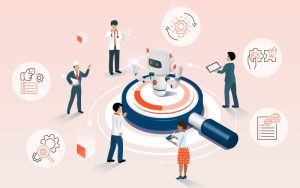When a learner opens a course that speaks their language and their culture, something changes. The examples make sense. The tone feels familiar. Learning stops being translated and starts being transformed.
That’s what true localization delivers. In today’s global workplace, it’s not just a “nice to have.” It’s how leading organizations build engagement, trust, and performance across borders.
And with BrinX.ai, localization is finally as fast and scalable as the learning it supports.
With the global localization market projected to exceed $30 billion by 2030, the question isn’t if you’ll localize, but how fast and how well.

The Problem: Translation Without True Localization
Many organizations still equate translation with localization. But true localization goes deeper. It adapts visuals, scenarios, humor, measurement systems, and even compliance references to fit each audience’s world.
Without it, learners experience cognitive dissonance, that subtle but powerful friction that makes content feel “off.” According to Cognitive Load Theory, this unnecessary mental effort distracts from learning, reducing retention and transfer.
Localization isn’t just about respect for culture; it’s about optimizing cognitive processing.

Why It Matters Now
Global enterprises are scaling learning faster than ever, across time zones, devices, and demographics. Yet, one-size-fits-all English content doesn’t scale cultural relevance.
Three major shifts make localization urgent:
-
Hybrid workforces are more globally distributed.
-
Regulatory training demands cultural accuracy.
-
AI tools make localization scalable and affordable.
As learning teams adopt AI-driven content pipelines, localized learning becomes a measurable differentiator, driving higher completion rates and better learner satisfaction scores (Kirkpatrick Level 1).

The Strategic Edge: Localization as Business Enablement
Think of localization as a multiplier for learning ROI. When learners understand and relate to training:
-
Completions rise.
-
Behavior change sticks.
-
Skills transfer faster.
From a Kirkpatrick Level 3–4 perspective, localized learning impacts not just learning, but also on-the-job performance and business outcomes.
For instance, a global sales enablement program localized for Latin American markets might use region-specific negotiation scenarios, leading to measurable sales lift because the learning context mirrors reality.

The BrinX.ai Advantage
BrinX.ai’s localization engine turns what was once a manual, expensive process into a scalable competitive advantage.
With AI-driven contextual translation, tone-sensitive adaptation, and auto-deployment in multilingual LMS environments, BrinX.ai helps organizations:
Translate content with semantic precision (not word-for-word literalism)
Adapt tone, idioms, and references to fit each region’s learner mindset
Deploy localized versions instantly, reducing turnaround time from weeks to hours
This aligns with Merrill’s First Principles of Instruction, which emphasize relevance and real-world application. When learners see themselves reflected in content, motivation (ARCS: Attention, Relevance, Confidence, Satisfaction) naturally increases.

Practical Takeaways
Start with the learner, not the language. Define your cultural personas during the Analyze phase of ADDIE.
Automate smartly. Use AI for initial translation but ensure cultural QA from regional reviewers.
Prioritize microlearning for localization. Smaller chunks are easier to adapt and update.
Measure what matters. Track localized completion rates, satisfaction, and application behavior to prove ROI.

Global Compliance at Scale
A Fortune 500 manufacturer using BrinX.ai localized compliance training in 14 languages in under a week. The results:
-
92% completion rate across regions (up from 67%)
-
40% faster deployment
-
Consistent compliance pass scores globally
Localization didn’t just make the content accessible; it made it effective.

Common Pitfalls to Avoid
-
Over-relying on machine translation without cultural validation
-
Ignoring regional regulatory nuances
-
Localizing copy but not visuals or interactions
-
Treating localization as a one-time task rather than a continuous improvement loop

Conclusion
Localization isn’t a line item; it’s a leadership decision. In a global learning ecosystem, context is the new currency of connection.
With BrinX.ai, localization becomes seamless, scalable, and strategic, turning training into a unifying global experience rather than a fragmented one.
Ready to make your training globally relevant?

FAQs: Localization in Global eLearning (2025 Edition)
Why is localization essential for global eLearning?
Localization ensures training feels natural and relevant to every learner, not just translated. It adapts tone, examples, and visuals to each culture, improving engagement, knowledge retention, and learning outcomes across regions.
What’s the difference between translation and localization?
Translation converts text between languages. Localization adapts the full experience language, tone, visuals, and cultural references, so learning content feels native and contextually accurate to each audience.
How does localization improve training ROI?
Localized eLearning drives measurable impact: higher completion rates, stronger knowledge retention, and improved performance. When learners connect with content emotionally and culturally, engagement translates directly into business results.
Why is localization now a business differentiator?
As global teams grow, relevance has become a competitive advantage. The localization market is projected to exceed $30 billion by 2030, signaling that culturally adapted learning is no longer optional, it’s strategic.
How does BrinX.ai make localization faster and smarter?
BrinX.ai uses AI-powered contextual translation to adapt training in multiple languages with cultural accuracy. It preserves tone, intent, and instructional design flow, reducing localization time from weeks to hours.
What learning science supports localization?
Cognitive Load Theory shows learners retain more when content fits their cultural schema. Dual Coding Theory reinforces that aligning words and visuals across cultures boosts comprehension and memory.
What are common localization mistakes in eLearning?
-
Using literal translation without cultural QA
-
Ignoring visuals or tone of voice
-
Treating localization as one-time work
-
Missing accessibility or compliance nuances
How can organizations measure localization success?
Use Kirkpatrick’s Four Levels—track engagement, learning, behavior, and results. Compare completion rates and feedback across languages to identify where localization boosts impact.
How can L&D teams start localizing effectively?
Begin in the Analyze stage of ADDIE: identify cultural needs and key regions. Automate translation with AI, validate with local reviewers, and iterate using learner feedback for continuous improvement.
What sets BrinX.ai apart from other localization tools?
BrinX.ai doesn’t just translate, it understands. Its AI engine interprets meaning, tone, and instructional intent, creating culturally relevant eLearning that feels human and consistent across global audiences.

Soft Skills Deserve a Smarter Solution
Soft skills training is more than simply information. It is about influencing how individuals think, feel, and act at work, with coworkers, clients, and leaders. That requires intention, nuance, and trust.






